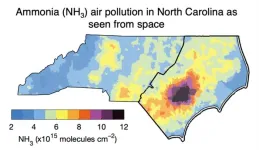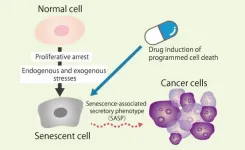(Press-News.org) Thirty years after the discovery of the first exoplanet, we detected more than 7000 of them in our Galaxy. But there are still billions
more to be discovered! At the same time, exoplanetologists have begun to take an interest in their characteristics, with the aim of finding life elsewhere in the Universe. This is the background to the discovery of super-Earth HD 20794 d by an international team including the University of Geneva (UNIGE) and the NCCR PlanetS. The new planet lies in an eccentric orbit, so that it oscillates in and out of its star’s habitable zone. This discovery is the fruit of 20 years of observations using the best telescopes in the world. The results are published today in the journal Astronomy & Astrophysics.
‘‘Are we alone in the Universe?’’ For thousands of years, this question was confined to philosophy, and it is only very recently that modern science has begun to provide solid hypotheses and evidence to answer it. However, astronomers are making slow progress. Each new discovery, whether theoretical or observational, adds to the edifice by pushing back the limits of knowledge. This was the case with the discovery in 1995 of the first planet orbiting a star other than the Sun, which earned two UNIGE researchers, Michel Mayor and Didier Queloz, the 2019 Physics Nobel Prize.
Nearly thirty years later, astronomers have taken many small steps towards detecting more than 7,000 of these exoplanets. The current scientific consensus points to the existence of a planetary system for every star in our galaxy. Astronomers are now looking for exoplanets that are easier to characterise or have interesting features to test their hypotheses and consolidate their knowledge. This is the case of planet HD 20794 d, which has just been detected by a team that includes members of the UNIGE Astronomy Department.
In the habitable zone of its star
This promising planet is a super-Earth, a telluric planet larger than the Earth. It is part of a planetary system containing two other planets. It orbits a G-type star, like the Sun, at a distance of just 19.7 light-years, which is, on the scale of the Universe, in the very close neighbourhood of the Earth. This ‘‘closeness’’ makes it easier to study, as its light signals are more visible and stronger. ‘‘HD 20794, around which HD 20794 d orbits, is not an ordinary star,’’ explains Xavier Dumusque, Senior Lecturer and researcher in the Department of Astronomy at the UNIGE and co-author of the study. ‘‘Its luminosity and proximity makes it an ideal candidate for future telescopes whose mission will be to observe the atmospheres of exoplanets directly.’’
The interest in planet HD 20794 d lies in its position in the habitable zone of its star, the zone that delimits the place where liquid water can exist, one of the conditions necessary for the development of life as we know it. This zone depends on several factors, mainly the stellar properties. For stars such as the Sun or HD 20794, it can extend from 0.7 to 1.5 astronomical units (AU), encompassing not only the orbit of the Earth but also that of Mars in the case of the Sun. The exoplanet HD 20794 d takes 647 days to orbit its star, around forty days less than Mars.
Instead of following a relatively circular orbit, like the Earth or Mars, HD 20794 d follows an elliptical trajectory with large changes in the distance to its star during its revolution. The planet thus oscillates between the inner edge of its star HZ (0.75 AU) and outside of it (2 AU) along its orbit. This configuration is of particular interest to astronomers because it allows them to adjust theoretical models and test their understanding of the notion of a planet’s habitability. If there is water on HD 20794 d, it would pass from the state of ice to the liquid state, conducive to the appearance of life, during the planet’s revolution around the star.
Many years of observations
Detecting this super-Earth was not easy and the process was iterative. The team analysed more than twenty years of data from state-of-the-art instruments such as ESPRESSO and HARPS. For the latter, the scientists were able to rely on YARARA, a data reduction algorithm recently developed at the UNIGE. For years, planetary signals had been obscured by noise, making it difficult to discern whether planets actually existed. ‘‘We analysed the data for years, carefully eliminating sources of contamination,’’ explains Michael Cretignier, a post-doctoral researcher at Oxford University, co-author of the study and developer of YARARA during his PhD at UNIGE.
The discovery of HD 20794 d provides scientists with an interesting laboratory for modelling and testing new hypotheses in their search for life in the Universe. The proximity of this planetary system to its bright star also makes it a prime target for next-generation instruments such as the ANDES spectrograph for ESO’s Extremely Large Telescope (ELT). Knowing whether this planet harbours life will still require a number of scientific milestones and a transdisciplinary approach. The conditions for its habitability are already being studied by the new Centre for Life in the Universe (CVU) at the UNIGE’s Faculty of Science.
END
A super-Earth laboratory for searching life elsewhere in the Universe
An international team, including the UNIGE, has discovered a super-Earth that will enable astronomers to test new hypotheses in the search for life in the Universe.
2025-01-28
ELSE PRESS RELEASES FROM THIS DATE:
Testing the effect of thousands of compounds on cellular metabolism
2025-01-28
Researchers at the University of Basel are able to test in parallel the effects of over 1500 active substances on cell metabolism. Their analysis also led to the discovery of previously unknown mechanisms for known medications. This approach might help scientists to better predict side effects and find additional uses for commercially available pharmaceuticals.
How do active substances alter metabolic processes in cells? Answering that question would provide valuable clues for the development of new medications. ...
Follow the water: Searching for a lunar oasis
2025-01-28
As humankind imagines living off-planet — on the moon, Mars and beyond — the question of how to sustain life revolves around the physical necessities of oxygen, food and water. We know there is water on the moon, but how do we find it? Is it in the craters? The shadowed regions? The poles? Knowing where to look gives astronauts the best chance at successfully living on the moon, something that has, heretofore, remained the stuff of science fiction.
Researchers from the University of California ...
Ocean-surface warming four times faster now than late-1980s
2025-01-28
The rate of ocean warming has more than quadrupled over the past four decades, a new study has shown.
Ocean temperatures were rising at about 0.06 degrees Celsius per decade in the late 1980s, but are now increasing at 0.27 degrees Celsius per decade.
Published today (Tuesday, 28 January 2025) in Environmental Research Letters, the study helps explain why 2023 and early 2024 saw unprecedented ocean temperatures.
Professor Chris Merchant, lead author at the University of Reading, said: “If the oceans were a bathtub of water, then in the 1980s, the hot tap was running slowly, warming up ...
Study explores whether dietary supplement could provide first effective treatment for cirrhosis
2025-01-28
A dietary supplement used to build muscle – or prevent muscle loss as a result of ageing or illness – is to be trialled as a potential treatment for chronic liver disease.
Β-hydroxy β-methylbutyrate, otherwise known as HMB, is used predominantly to build muscle bulk and function but previous studies have demonstrated it can have clinical applications.
In a new study, scientists and clinicians will test its potential to benefit some of the 60,000 people in the UK who have been diagnosed with cirrhosis, a condition that results from scarring to the liver.
In the UK, cirrhosis is most commonly caused by harmful alcohol use or fatty liver disease. In severe cases, those ...
Individual cells can be connected to plastic electrodes
2025-01-28
Researchers at Linköping University have succeeded in creating a close connection between individual cells and organic electronics. The study, published in Science Advances, lays the foundation for future treatment of neurological and other diseases with very high precision.
“We could target individual cells and explore how this affected their ability to stay healthy and functional,” says Chiara Musumeci, researcher at the Laboratory of Organic Electronics, LOE, at Linköping University.
The brain is controlled by electrical signals that are converted into chemical substances in the communication between the brain ...
University of Virginia study reveals air pollution inequities linked to industrial swine facilities are detectable from space
2025-01-28
A groundbreaking study led by researchers from the University of Virginia has used satellite measurements to show the long-term persistence of air pollution inequalities tied to industrialized swine facilities in Eastern North Carolina. Using satellite data spanning a 15-year period from 2008–2023, the study quantifies disparities in ammonia (NH₃) — an air pollutant emitted by swine operations — for Black, Hispanic and Indigenous communities. These inequalities, exacerbated by hot and calm weather ...
Cell death and aging in cancer research review
2025-01-28
Aging cells secrete substances known to promote the growth of cancer cells. The development of drugs that can selectively kill these cells or inhibit the secretion of substances is ongoing. The latest findings on the interaction between cell death and cellular senescence in cancer and their pathophysiological significance have been reviewed by a team from Osaka Metropolitan University’s Graduate School of Medicine and Harvard Medical School.
Lecturer Kouhei Shimizu and Professor Fuminori Tokunaga of OMU and Dr. Hiroyuki Inuzuka of Harvard Medical School outlined ...
Flame retardants in battery enclosures may do more harm than good
2025-01-28
As dangerous lithium-ion battery fires are on the rise, regulators and manufacturers are scrambling for solutions. Unfortunately, one common strategy may cause serious health harm and not work to slow or stop the fires. A new Viewpoint in Environmental Science & Technology explains that adding flame retardants to the plastic cases surrounding these batteries has no proven fire-safety benefit. The scientists further warn that the types of flame retardants widely used in electronics enclosures are linked to cancer and other health harms and can end up in children’s toys, food containers, and other products made from recycled plastic.
“The use of flame ...
Kenya study highlights complexity of tree-planting schemes
2025-01-28
Research with smallholder farmers in Kenya shows that tree-planting schemes must account for complex local issues and preferences.
Tree planting is central to many countries’ climate mitigation and biodiversity conservation goals, and Kenya alone plans to plant 15 billion trees by 2032.
Adding trees and shrubs to farmland (called agroforestry) can boost biodiversity, carbon storage, soil health, food production and income. But many tree-planting schemes overlook diversity and promote a narrow range of species.
The new study – led by the University of Exeter – examined the factors that enable or prevent Kenyan smallholders from increasing the diversity of ...
Transforming longevity research: AI paves the way for personalised treatments in ageing science
2025-01-28
A collaborative study between researchers from the Yong Loo Lin School of Medicine, National University of Singapore (NUS Medicine), and the Institute for Biostatistics and Informatics in Medicine and Ageing Research, Rostock University Medical Center, Germany, investigated how advanced AI tools, like Large Language Models (LLMs), can make it easier to evaluate interventions for ageing and provide personalised recommendations. The findings were published in the leading review journal Ageing Research Reviews.
Research into ...
LAST 30 PRESS RELEASES:
Post-stroke injection protects the brain in preclinical study
Cardiovascular risk score predicts multiple eye diseases
Health: estimated one in ten British adults used or interested in GLP-1 medications for weight loss
Exercise to treat depression yields similar results to therapy
Whooping cough vaccination for pregnant women strengthens babies’ immune system
Dramatic decline in new cases of orphanhood in Uganda driven by HIV treatment and prevention programs
Stopping weight loss drugs linked to weight regain and reversal of heart health markers
Higher intake of food preservatives linked to increased cancer risk
Mass General Brigham–developed cholera vaccine completes phase 1 trial
First experimental validation of a “150-year-old chemical common sense” direct visualization of the molecular structural changes in the ultrafast anthracene [4+4] photocycloaddition reaction
Lack of support for people on weight loss drugs leaves them vulnerable to nutritional deficiencies, say experts
Dogs’ dinners can have greater climate impact than owners’
Are you ready to swap salmon for sprats and sardines?
1.6 million UK adults used weight loss drugs in past year
American College of Cardiology comments on new dietary guidelines for Americans
American Society of Gene & Cell Therapy and Orphan Therapeutics Accelerator partner to advance and commercialize promising rare disease treatments
One in 14 patients having day case surgery have new or worse chronic pain 3 months after their operation
New study highlights link between eviction rates and gun violence
Heatwaves heat up soil but not toxin levels in rice, study finds
Digital modeling reveals where construction carbon emissions really come from
Turning farm waste into water filters
New study shows how the spleen helps the immune system accept a transplant
New Mayo Clinic study advances personalized prostate cancer education with an EHR-integrated AI agent
Researchers identify novel therapeutic target to improve recovery after nerve injury
Microbes in breast milk help populate infant gut microbiomes
Reprogramming immunity to rewrite the story of Type 1 diabetes
New tool narrows the search for ideal material structures
Artificial saliva containing sugarcane protein helps protect the teeth of patients with head and neck cancer
Understanding the role of linear ubiquitination in T-tubule biogenesis
Researchers identify urban atmosphere as primary reservoir of microplastics
[Press-News.org] A super-Earth laboratory for searching life elsewhere in the UniverseAn international team, including the UNIGE, has discovered a super-Earth that will enable astronomers to test new hypotheses in the search for life in the Universe.




